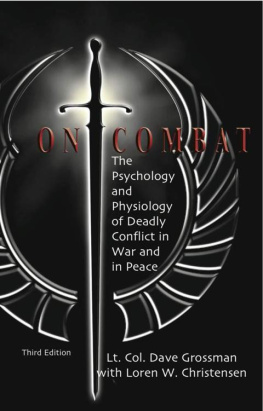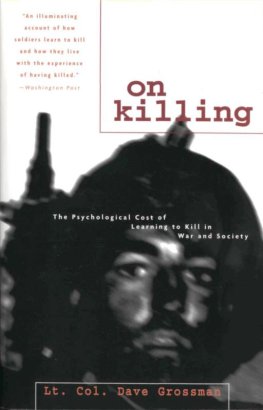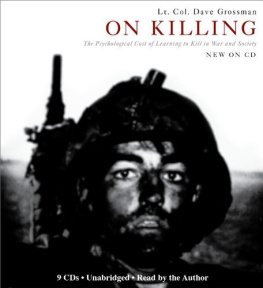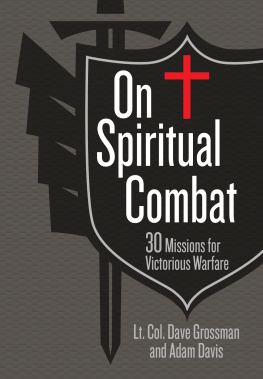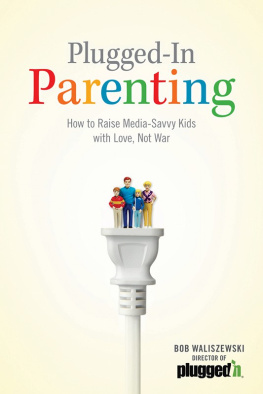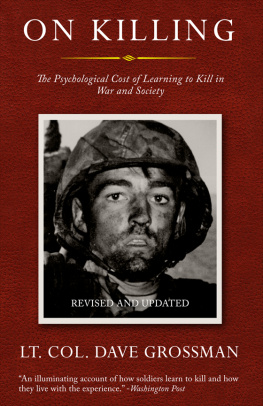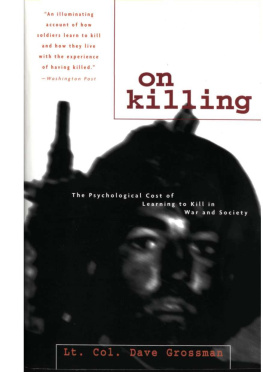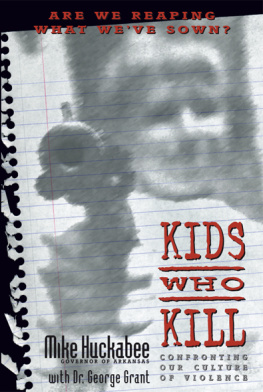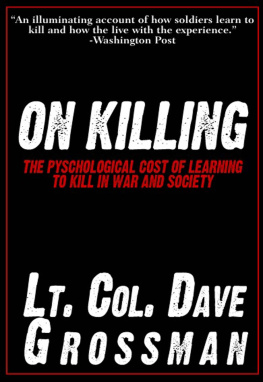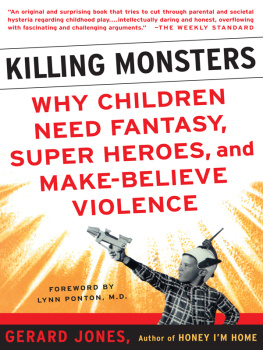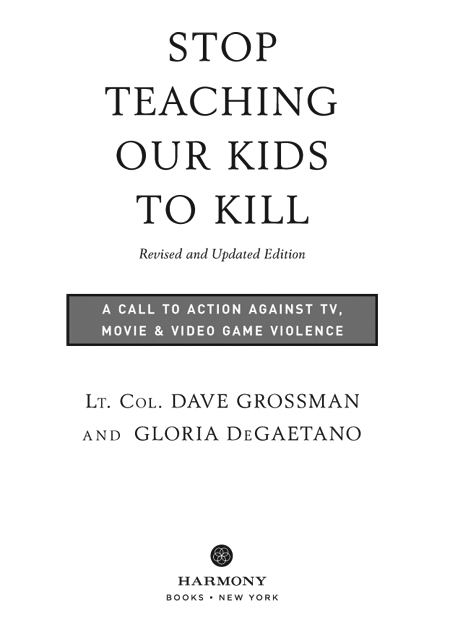ALSO BY LT. COL. DAVE GROSSMAN
On Killing: The Psychological Cost of
Learning to Kill in War and Society
On Combat: The Psychology and Physiology of
Deadly Conflict in War and in Peace
(with Loren W. Christensen)
ALSO BY GLORIA DeGAETANO
Left to Their Devices, Whats Left?
Parenting Well in a Media Age:
Keeping Our Kids Human
Copyright 1999, 2014 by Dave Grossman and Gloria DeGaetano
All rights reserved.
Published in the United States by Harmony Books, an imprint of the Crown Publishing Group, a division of Random House LLC, a Penguin Random House Company, New York.
www.crownpublishing.com
H ARMONY B OOKS is a registered trademark, and the Circle colophon is a trademark of Random House LLC.
A previous edition was published in hardcover in the United States by Crown Publishers, an imprint of the Crown Publishing Group, a division of Random House LLC, New York, in 1999.
Library of Congress Cataloging-in-Publication Data
Grossman, Dave.
Stop teaching our kids to kill: a call to action against TV, movie & video game violence / by Lt. Col. Dave Grossman and Gloria DeGaetano.Revised and updated edition.
pages cm
Includes bibliographical references.
1. Mass media and children. 2. Television and children. 3. Violence on television. 4. Children and violence.
I. DeGaetano, Gloria. II. Title.
HQ784.M3G76 2014
302.230835dc23 2013050666
ISBN 978-0-8041-3935-9
eBook ISBN 978-0-8041-3936-6
Jacket design by Michael Nagin
v3.1
To the children of the world
and
to the survival of their innocence
CONTENTS
INTRODUCTION
Its Not Normal
CHAPTER ONE
Its a Violent World For Our Kids
CHAPTER TWO
The Compelling Evidence
CHAPTER THREE
Murder, Torture, Brutality: Dangerous Games
CHAPTER FOUR
The Story I Tell Myself About Myself
CHAPTER FIVE
Actions Speak Louder Than Words
INTRODUCTION
ITS NOT NORMAL
The first edition of this book actually began in 1997 over a dinner conversation. We had become familiar with each others work through a mutual colleague and decided it was time to meet. Dave had written On Killing: The Psychological Cost of Learning to Kill in War and Society, which examined the armys conditioning techniques used to overcome soldiers aversion to killing. Now a classic, On Killing showed how media, particularly violent video games, replicate these techniques. Since 1987, Gloriawith no knowledge of Daves workhad been helping parents and professionals understand the conditioning effects of violent media from the perspective of child and adolescent brain vulnerabilities.
A lively discussion soon uncovered a mutual passion: We wanted parents, educators, law enforcement officersanyone working with children and youthto know without equivocation that media violence harms. We wanted to make people aware of how the prolific use of sensational violence in television, movies, and in video games affects kids attitudes and actions. We wanted to reveal the scientific research on the subjectresearch that couldnt make clearer the deadly link between violent graphic imagery and the escalating incidence of youth violence. We wanted anyone who cares about kids to understand that media violence is a serious threat to them, and to our society as well.
Now, in this revised 2014 edition, we have the same goals as we did in the original 1999 editionbut with much more urgency. Incredibly, misconceptions and misinformation still abound about media violence, leading to collective confusion and individual inaction. Parents throw up their hands in despair, so frustrated with their kids video game habits that they have given up. Teachers are at their wits end with the culture of cruelty in their schools. And congressional debates about what to do about media violence come and go while our kids get better at killing. Today it seems inevitable that the kids who gave us Jonesboro in the middle school and Littleton in the high school are now giving us mall massacres, workplace shootings, and college rampages. Why? Because we have not yet done enough to address the root cause of the problem.
And that root cause is the steady diet of violent entertainment our kids see on TV, in movies, and in the video games they playas they sit in front of their screens and digital devices for forty hours each week. This amount of continuous exposure to gratuitous violent images sensationalizing murder, rape, and torture is neither benign nor cathartic. The fact is that media violence primes children to see killing as acceptable.
Over the years we have heard firsthand many horror stories that show the link between media violence and aggression. Teachers report first graders stabbing kittens to death and mutilating pets after seeing violent acts on TV or in a movie. Parents observe preschoolers attempting to drown siblings because a cartoon hero drowned an enemy on TV. Law enforcement officers tell of the hundreds of preteens who plot murder and revenge and luckily are stopped before the tragedy occurs. Adolescents who copy crimes they see on television do so with cold-blooded calculation and without remorse. They even detect and correct the flaws that may have caused the television crime to fail.
Its abnormal for a civilized society to teach kids to kill people. And its certainly not normal for so many kids to want to kill, harm, bully, or hurt others as they do today.
We have deterred many violent crimes by putting thousands of armed police officers in our schools. But it seems that we have forgotten that it is not normal to put thousands of cops in our schools to stop our kids from killing each other. And its not normal for every kid in America to practice hunkering down, hiding under tables when their classmates come to kill them.
In recent years, we also have detected potential youth killers by the hundreds, catching them before they commit their crimes. But once again it is not normal to apprehend hundreds of kids every year who are planning to commit mass murders in our schools. The most fundamental shift in law enforcement tactics in our lifetime happened after Columbine. Today, Rapid Reaction and Active Mass Murder response programs train officers to go in and stop the killings. And it works. Most people never heard about what happened in the high school in Spokane, Washington, in 2003. The police were in that school in minutes and ultimately shot the suspect before he could take a single life. He survived. (Nobody died that day, so it is not on anybodys list of these brutal crimes.) The police who were there said one of the first things out of the shooters mouth was Howd you get here so fast?
Yes, police are good at entering our schools like thunder and shooting wannabe juvenile mass murderers before they can rack up a body count, but it is not normal. We dont know about you, but we are outraged that every police officer in America has to practice going into our schools and shooting our kids. Its not normal.


